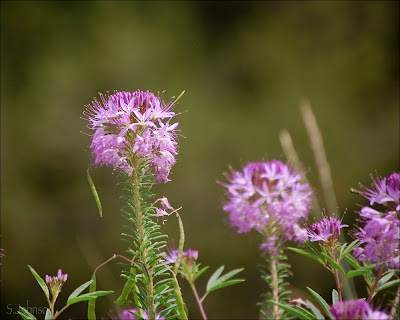On Tuesday afternoon, Wayne and I finally did what we'd been talking about for the better part of a year while we were back: an afternoon of fishing (for him) and plein air painting for me. It was simply awesome.
Haviland Lake is about 30 min. drive north of town along Hwy 550, nestled next to the Hermosa Cliffs at 8200'. It's surrounded by mostly a Ponderosa pine forest, with some spruce and fir thrown in. Along the slopes of the Hermosa cliffs to the west, large stands of aspen break into the evergreen forest. Mesozoic era sedimentary rock - sandstones and limestone - form the upper cliff edges, laid down millions of years before the Rocky Mountains came into existence. They sit atop older redbed shale layers that form the long slope now covered with trees.
The weather: perfect. Dry, with a slight breeze, and temps in the mid '80's. No bothersome insects, just lots of large dragonflies dashing around the lake edge. Masses of ever-changing cumulus congestus clouds filled much of the sky.
Probably 10 years ago, when I was living in Flagstaff, I purchased a French-style plein air easel with the intent to go painting outdoors. Well, that never happened. I did haul it out to AZ this winter with the same intent, but never used it outside.

In fact, in the past 20 years, I've only done one plein air painting and that was done on the back steps of my mom's house back in Tucson this spring. So, it was a historic moment, of sorts, to finally use my easel for its intended purpose!
I brought all 3 of my handmade pastel trays (foamboard, tape and T-pins) in their box, and used some of the Golden pumice ground + watercolor paper I'd made. After doing a quick casing of the area, I quickly a prime spot for painting, and went to work. Luckily, it was only about 200 yards from the car, so it didn't make the two trips lugging everything over there that unbearable.
I didn't do any preliminary sketches for composition, but instead used my thumbs and index fingers to form a viewfinder (free and always available - can't beat that!) and establish my composition. It came out mostly as I'd hoped.
As is often the case, the most difficult part of the process was simply trying to match local colors. I found I was lacking some important colors: darker blue-grays for the trees of the distal slopes. Scumbling colors to try and obtain what I was looking for didn't work. So, as a result, the cliffs are too light, value-wise. And, the water is too dark.

Here is the "finished" painting, after approximately 2 hrs. of work. No color correction, so it's a bit washed-out from the actual. Painting the middle distance of evergreens was always a good challenge - not easy to do. The clouds...next time, I'll probably wait until the end to work on the sky, unless there are some to-die-for clouds going on. When I painted them, they mostly filled the sky, which I knew I didn't want. So, they are somewhat contrived. Next time, I'll sit and do a dedicated painting of just the clouds.
I'm also not happy at all with the water; I think I should have just ignored what conventional landscape instruction says (that the sky is *always* the lightest value), because that was not the case. So, as a result, the painting lacks the impact that the view had, as my values for everything are simply too close.
Here is a photo, taken when clouds happened to have the middle ground trees in shade, of the basic view I was seeing. What this 55mm shot doesn't capture is the area of the cliff that rose up before dropping down to the view shown.

This was taken after I'd already done the shadows on the left, so there is significantly more of the cliff in shadow in the photo.
I am undecided as to whether I'll just bin the painting or try, for practice's sake, to rework it and see if I can fix some things.
Regardless of how the painting turned out, the trip and the process were a success, at least as far as this being the first time I've done a full landscape plein air painting before. Can't expect much more than that. I would like to hope that after I have 100+ plein air paintings behind me, they will look significantly better.
Also from the trip:
One of the two beautiful rainbow trout that Wayne caught that we had poached on the grill on the campground. I gave my thanks to the trout for its offering as nourishment.
By the time I'd finished my painting, the sun was just about gone behind the cliffs, making any sort of meaningful photography of the local area nearly impossible. But, I did take a walk over to the dam area of the lake, to go check out some hollyhocks, which seem to be one of the favored flowers of the higher elevations in the west/southwest.
And finally, a silhouetted shot of one of an unknown species of raptor as it flew across the lake, calling out to its mate:
All in all, it was a perfect day. It's what Wayne and I have been planning for and dreaming about ever since we moved to CT. I feel an excitement and sense of joy and well-being that I've not felt in close to 4 years.
It's good to be home.








































